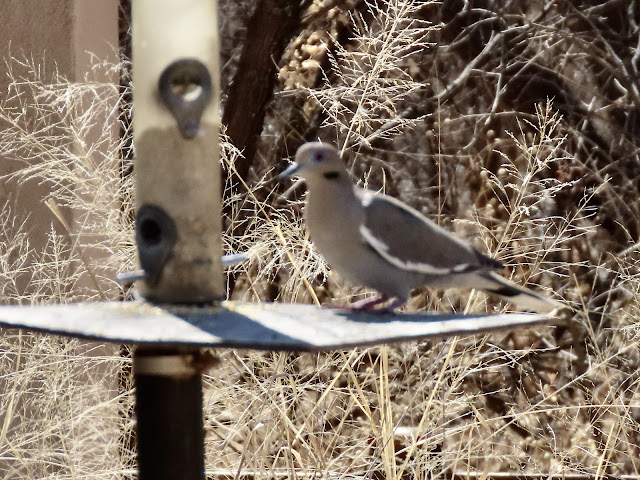March 9 and 16, 2022
Our Community Birding Group has continued to come up with some excellent sightings on its past two outings.
1. First, on March 9th, at Boyce Thompson Arboretum which opens at 8:00 a.m., we had viewable visits from three hummingbirds before we even left the plaza area: ANNA’S, COSTA’S and BROAD-BILLED. Nothing like getting our hopes up for a great day (42-62°F) under a clear sunning sky. Moving too fast for my camera, the photos below (from BTA) are from my files.
Anna's Hummingbird, March 2012 (Babs' file photo)
Broad-billed Hummingbird, photo dated May 2020 (Babs' file photo)
Costa's Hummingbird, photo dated February 2014 (Babs' file photo)
Starting out at the Demonstration and Wallace Gardens, heads swiveled this way and that as birds vocalized around us. NORTHERN CARDINAL and YELLOW-RUMPED WARBLER were easier to spot due to larger size than the smaller songbirds. Photo below was taken in the Wallace Garden.
NORTHERN CARDINAL
At the front of the group crossing the bridge over Queen Creek, Judy and I confirmed the sighting of the rarity reported at BTA. Judy confirmed the warbler’s dark bill, its long eyebrow (supercilium) and its white lower eye arc. With the bird slightly above us in the tree, I caught its smooth buffy underparts with white under-tail coverts. It flew deeper into the tree before any of us could get a photo of the female BLACK-THROATED BLUE WARBLER. With no photo of the female in my files; this was taken from the "commons" online.

Ayer Lake often produces the same birds each time, but not today. Very unusual, we loved getting looks at a SORA, directly across from the ramada where we stood. In the bright sunlight, two birds settled down against the reeds near the Sora appeared to be American Coot (a usual bird there), but in Glenda’s photos, turned out to be CINNAMON TEAL. The usual PIED-BILLED GREBE swam close to us. Several NORTHERN ROUGH-WINGED SWALLOW circled the Lake a couple times diving down for insects on the surface. VIOLET-CROWNED SWALLOW was my first-of-season (FOS) sighting. I thought the chatter of a MARSH WREN would round out our unusual sightings. Then someone spied a GREAT BLUE HERON up on the rocks high above Ayer Lake.
Pied-billed Grebe
Hinde took this photo below of our birding group. She was standing in the dry creek bed ( Queen Creek). The BLACK-THROATED BLUE (female) was to the right.
View this checklist online at https://ebird.org/checklist/S104503295
* * *
2. The following week, our Community Birders headed farther northeast to BUSHNELL TANK TRAILHEAD.
We no sooner stepped out on the trail than we were seeing Sparrows flying from one bush to another. I think it was Glenda who found a real treasure among them: GREEN-TAILED TOWHEE.
Another good find down among the Cottonwoods beside Sycamore Creek was a singing LUCY'S WARBLER.
Lucy's Warbler; Babs' file photo 2020
The only other photo I managed that day was of the COMMON RAVEN which eventually perched atop a big pile of stones.[Below]
View this checklist online at https://ebird.org/checklist/S104940605
Not birdy enough to hold us there longer (without a long time commitment), we stopped at SUNFLOWER on our way down the highway.
With events going on at our RV Park that morning and afternoon, it was our intent to stop at Sunflower only briefly. Staying a bit longer than intended, we managed to see birds that were not specific to that location but ones quite familiar to us.
View this checklist online at https://ebird.org/checklist/S104944907
* * *





















































